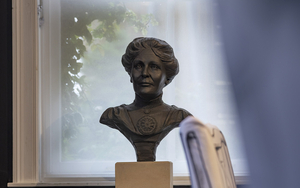Ahead of a full-on review of the new museum we sent in a dogged soccer sceptic to test its appeal and its claims to provide interest for everybody.
FOOTBALL gets on my nerves. I don’t get what all the fuss is about.
The excesses of the cynical prima donnas who play the game for hugely inflated wages disgust me. What often seems like the bovine gullibility of the people who continue to pay through the nose to watch these same prima donnas continues to baffle me. And the assumption that everyone everywhere simply has to be into football irritates the hell out of me.
I’m most impressed by the temporary exhibitions on the top floor of the museum, which at the moment are Stuart Roy Clarke’s evergreen Homes of Football.
I understand these are not popular views. Everyone is into football now, even the middle classes. I blame Nick Hornby.
My refusenik former allies – women, gays, ethnic minorities and so on – have now been sucked into the footballing vortex. Some have even formed their own five-a-side teams. Good for them. But it’s not for me.
As a confirmed conscientious objector, I’m well placed to test the National Football Museum’s claim to cater for 'everyone, regardless of age, gender, disability, sexuality, religion or any other factor.' The museum, we’re told, 'is not just for those who are interested in or passionate about the sport'.
While Urbis might have been built without any clear purpose in mind, apart from to spend all that Millennium Commission cash (leading to the much-maligned ‘museum of the modern city’ being shoe-horned into the space), Ian Simpson’s glass and steel edifice remains a beautiful and arresting addition to Manchester's skyline.
This extraordinary and unique building looks like the kind of glittering sci-fi future we were promised by Things To Come and Star Trek - rather than the drearily dystopian future of misery, austerity and One Direction we actually ended up with.
But how does the National Museum of Football fit into that glittering future?
The free entry museum is divided into a Hall of Fame on the ground floor, with first and second halves on the first and second mezzanine floors respectively and a learning zone and gallery space at the top of the building.
Keywords are highlighted around the ground floor: Drama, History, Skill, Passion, Art, Faith and Style. As far as I am aware, football does not hold a monopoly on these attributes. You could say much the same about the Women’s Institute.
An introductory section on the early origins of the game presents various oddly and not-so-oddly shaped balls – including, inevitably perhaps, the 1966 World Cup Final ball. You’ll also find the first rules of Association Football, handwritten by the splendidly named Ebenezer Cobb Morley in 1863, and an undeniably lovely quilted abstract of Diego Maradona by Chris Holwell.
Many of the other exhibits on the first floor are less engaging for someone not utterly consumed by the minutia of the supposedly Beautiful Game. There’s a ridiculous amount of tat and ephemera, from vintage programmes, cigarette cards and rattles to more modern branded annuals, wellington boots and clapsticks (whatever the hell they are).
My fellow visitors (mostly lads and older blokes, with the occasional young lady, maybe even the odd WAG) seem absolutely fascinated by this stuff.
Fortunately, exhibits on the changing attitudes towards and within the game over the years hold a more interest for non-aligned visitors like myself.
A cabinet of lethal weapons confiscated from fans in the glory days of football hooliganism in the 1980s is grimly fascinating.
One of the most touching areas of the whole museum examines the story of the only openly gay player English football has ever seen, Justin Fashanu, complete with the glittery pink and blue Justin Campaign trophy that bears his name. Displays about racism within the game have a similar poignancy – as well as, sadly, a similar contemporary relevance.
I eavesdrop on one teenage lad telling his mates about Fashanu, who they have never heard of before. “That’s fucking mad,” one decides, and you can’t really argue with that.
One corner of this floor is dedicated to British footballing superstars such as Dixie Dean, George Best and David Beckham, while there’s also a reproduction of Michael Browne’s splendidly homoerotic portrait of Eric Cantona. No doubt Justin would approve.
A section on the relationship between football and television becomes tiresome. How many pictures of Gary Lineker in a TV studio does one museum need? And precisely how much value would visitors from Argentina or Japan find in John Motson’s sheepskin coat? Not a lot, it turns out. I asked.
I’m more impressed by one of the clips on the TV Heaven interactive big screen, from The IT Crowd where Moss and Roy inadvertently attend a football match.
“I imagine them to have grown up reading sci-fi, not liking football, being bullied and not having very good social skills,” explains the show’s creator Graham Linehan. Finally something I can truly get onboard with.
The idea that ‘interactivity’ is an essential part of any new cultural attraction looms large throughout the National Museum of Football. Visitors can buy Football Plus tickets that allow you to pit your skills against the professionals with penalty shoot-outs, match commentaries and the like.
There are also free interactive options such as consoles that invite visitors to have their ‘shout’ on whether FIFA has made the right decision on goal line technology, tumblers which allow you to assemble your own mascots and even a ‘Beat the Kaiser’ tilting trench game from the First World War, as well as all manner of touchscreen fun. All of this stuff seems as popular with adults as kids.
I’m most impressed by the temporary exhibitions on the top floor of the museum, which at the moment are Stuart Roy Clarke’s evergreen Homes of Football documentary photography and Moving Into Space: Football and Art in West Africa.
The latter includes Romauld Hazoumè’s powerful Exit Ball, a huge Death Star-like artwork made from sliced up jerry cans that examines the way in which football distracts fans’ attention from the grim realities of life. No doubt many fans would say that’s the whole point.
There’s also some excellent vintage photography throughout the museum, like the picture of a young lad being passed over the heads of a crowd on the terraces on the first floor. Personally, I could look at pictures of old men in flat caps all day – and by now, I’m beginning to feel like I’ve done exactly that.
Another big plus for the museum as a whole are the staff who are, without exception, genuinely friendly, engaged and attentive. One guy in the gift shop, who worked at the museum’s original home in Preston, tells me that the most popular branded items are neither City or United merchandise but that of West Ham.
The exhibits at the National Museum of Football perhaops won’t win any new converts but confirmed fans, whatever their allegiance, will find a lot to love.
The museum misses a couple of tricks – from the point of view of this non-footballing old punk, at least.
Interactive consoles allow fans to replay memorable match commentaries but Mark E Smith’s unique reading of the results on Final Score is strangely absent. Similarly, the Subbuteo display should probably include some reference to the Undertones’ My Perfect Cousin (“He always beat me at Subbuteo, cause he flicked the kick and I didn’t know ..”).
Other than that, it’s pretty on the ball. Even for a football hater it has its very entertaining moments.
The exhibits at the National Museum of Football perhaops won’t win any new converts but confirmed fans, whatever their allegiance, will find a lot to love. And even the most dyed-in-the-wool football-hater will probably find something of interest in this considered, accomplished and comprehensive collection.
So what did I learn? Well, apparently goalies wore heavy-duty woollen jumpers until 1909. England didn’t choose to enter the World Cup until 1950. LS Lowry’s Going to the Match, which I always assumed portrayed Old Trafford, is in fact Bolton Wanderer’s old Burnden Park ground.
And I learned that I never want to see Willie Cunningham’s preserved cartilage ever again.













